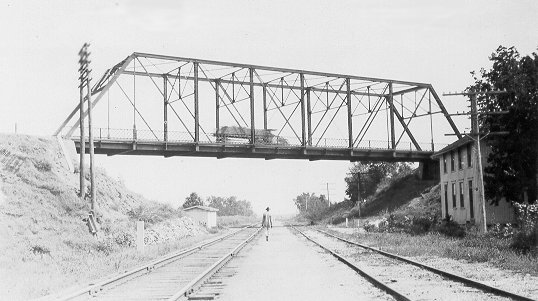|
TRUSS LEG BEDSTEAD PONY
1901 Kay 36E0040N3250001 American Br.
1902 Kay 36E3140N0180001 Kansas City Br.
1902 Kay 36E0110N3200005 Canton Br.
1907 Noble 52N3260E0390003 Midland Br.
1907 Pawnee 59N3500E0370006 Canton Br.
1908 Okmulgee 56E0890N3900004 R.K. Hughes
1909 Osage 57E0320N3830008 Missouri Valley Br.
1909 Wagoneer 73N4155E0640001 Central States Br.
c1910 Kay 36E0220N3240009 Canton Br.
1910 Rogers 66E0300N4270001 Missouri Valley Br.
1912 Lincoln 41N3510E0840006 Kansas City Br.
1914 Creek 19E0870N3610005 Toledo Massillon Br.
1915 Washington 74N4010E0030002 Rochester Br.
1915 Washington 74N4030E0350006 Rochester Br.
1915 Washington 74E0100N4030002 Rochester Br.
1925 Washington 74E0330N3970009
1929 Okmulgee 56E0870N3870007 Vincennes Br.
Termed a truss leg pony because of its perpendicular endposts that made the structure virtually self-supporting, the Pratt bedstead found considerable favor within Oklahoma counties improving rural roads early in this century. Some of the first documented trusses erected in the state, principally those remaining in Kay County (Figure 44) are of this type. A simple variation from the ordinary Pratt pony meant that most companies active in Oklahoma could provide truss leg bedsteads. The structures that remain today offer a good sample of builders, including leaders such as the Canton Bridge Company and the Midland Bridge Company of Kansas City (Figure 45). Important nationally, though less active in this state, Toledo Massillon from Ohio, and the Central States Bridge Company of Indianapolis built bedsteads in Oklahoma (Figure 46).
County commissioners found the bedstead appealing for its self-supporting characteristic, saving them from making a costly substructure. With this type the abutment could be simplified to the point where it was merely a timber or metal plate to form a connection with the bank and reduce sloughing. Oklahoma bedsteads generally had the vertical supports made of angles riveted together by lacing bars, rolled steel channel for the upper chord and eyebars for the bottom chord. A standard diagonal consists of eyebar, and the counter was formed from cylindrical eyebar. A few bridges have distinctive features. The Canton company on occasion attached its diagonals to the top chord with two exposed nuts (Figure 47). A 1902 Kansas City Bridge Company bedstead in Kay County utilized cotter pins to fasten the joint pins (Figure 48). Making an interesting exception to the reputation of the Missouri Valley Bridge Company as a builder of big through trusses, in a bedstead built in 1910 north of Chelsa in Rogers County.
The same characteristics that helped sell the bedstead to the counties, however, could also become weaknesses. They were vulnerable to floods or became rickety and unsafe if not strengthened with bracing or their legs set in concrete or rock-filled tubes.
|



